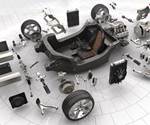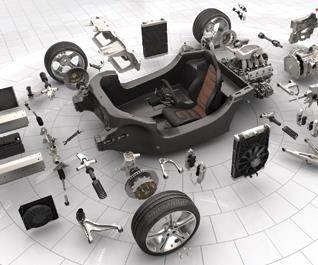Automotive weight reduction is increasingly about avoiding extra costs
Depending on the vehicle and the total miles driven, fuel efficiency gains by 2025 could save car owners from a few hundred to as much as $4,000 per year in fuel costs alone.
Improving automotive fuel efficiency, and thus reducing emissions, has a direct impact on operating costs. Depending on the vehicle and the total miles driven, fuel efficiency gains by 2025 could save car owners from a few hundred to as much as $4,000 per year in fuel costs alone. However, the potential for such savings has, so far, had much less impact on buying habits than the upfront purchase price. Unfortunately, estimates predict that meeting fuel economy standards will drive up the cost of small and midsize vehicles by $1,800 to $3,000 or more — an unhappy outcome for automaker and car buyer alike. The big question, then, is how to create incentives for change.
From a governmental point of view, the solution has been to set new mandates and regulations and impose taxes. Based on announced country and regional targets from around the world, CO2 emissions from passenger vehicles are expected to drop 20 percent or more from current levels. Racing to catch up with much of the rest of the world, the U.S. is targeting emissions levels of less than 107g of CO2 per kilometer by 2025 — about half what is permitted today. Over the next 12 years, auto OEMs must roughly double vehicle fuel economy. If these standards go unmet, manufacturers and consumers will be burdened with substantial taxes and fees.
By now most U.S. automobile owners have heard of the “gas guzzler tax,” which is levied on the sale of cars that cannot meet the minimum 22.5 mpg for combined city/highway driving. This tax, collected by the Internal Revenue Service, ranges from $1,000 to as much as $7,700 for vehicles with mileage ratings of less than 12.5 mpg. For the majority of compact and midsize vehicles sold in the U.S., this is not an issue. But it is an issue for luxury and performance cars and SUVs. The BMW M3 sport coupe, for example, has a city/highway mpg rating of 14/20. That imposes a $1,300 gas-guzzler tax. The much less efficient Mercedes-Benz S-Class sedan, along with the Bentley Continental and Lamborghini Gallardo, have taxes of about $3,000 each. It seems likely that the mileage ratings will be shifted up to match overall fuel efficiency standards, potentially snaring a wider range of vehicles at even higher rates.
The new corporate average fuel economy (CAFE) standards in the U.S. and similar rules in other countries offer an additional incentive for OEMs to innovate. Consider this hypothetical scenario: Luxury automobile manufacturer X, which sells 100,000 vehicles annually in the North American market, can raise its average fuel economy from today’s 29 mpg to 40 mpg by 2025, a 33 percent improvement. But it still fails to meet the 55 mpg target. The current fine that’s assessed to the manufacturer is $55 per 1 mpg under the standard, multiplied by the manufacturer's total production for the U.S. domestic market. In this scenario, manufacturer X would be fined approximately $82.5 million. Similar incentives exist in Europe, but they are even more onerous. In the U.K., failure to meet emissions standards results in a fine of €95 ($123 USD) per gram of CO2 per kilometer over the limit per vehicle. For flagship Jaguar Land Rover Ltd. (Whitley, Coventry, U.K.) sedans or Aston Martin (Gaydon, Warwickshire, U.K.) sports cars, this represents as much as an additional $20,000 or more per vehicle.
Over the past three decades in which such fines have been imposed, luxury vehicle manufacturers have generally been willing to pay so they can deliver the vehicles their customers demand. Since 2008, the National Highway Traffic Safety Admin. reports that CAFE fines were assessed 187 times. Among some of the popular luxury brands affected are:
- BMW: 24 times
- Fiat/Ferrari/Maserati: 29 times
- Jaguar Land Rover Ltd.: 20 times
- Mercedes-Benz: 25 times
- Volkswagen/Audi/Porsche: 35 times
Combined, these fines represent more than $785 million in extra costs to the OEMs. In the past it may have been expedient to continue offering high-performance vehicles and paying the fine, but this analysis shows that the costs going forward have a much greater potential to impact a company’s profitability. With trucks, sport utility vehicles and crossover utility vehicles now having to meet heightened emissions standards, the total magnitude of the fines are emphasized.
Related Content
SMC composites progress BinC solar electric vehicles
In an interview with one of Aptera’s co-founders, CW sheds light on the inspiration behind the crowd-funded solar electric vehicle, its body in carbon (BinC) and how composite materials are playing a role in its design.
Read More“Structured air” TPS safeguards composite structures
Powered by an 85% air/15% pure polyimide aerogel, Blueshift’s novel material system protects structures during transient thermal events from -200°C to beyond 2400°C for rockets, battery boxes and more.
Read MoreTPI manufactures all-composite Kenworth SuperTruck 2 cab
Class 8 diesel truck, now with a 20% lighter cab, achieves 136% freight efficiency improvement.
Read MoreCarbon fiber, bionic design achieve peak performance in race-ready production vehicle
Porsche worked with Action Composites to design and manufacture an innovative carbon fiber safety cage option to lightweight one of its series race vehicles, built in a one-shot compression molding process.
Read MoreRead Next
Automotive CFRP: Repair or replace?
As more carbon composites are used on structural car components, how will crash damage be assessed and repairs be made?
Read MoreDeveloping bonded composite repair for ships, offshore units
Bureau Veritas and industry partners issue guidelines and pave the way for certification via StrengthBond Offshore project.
Read MorePlant tour: Daher Shap’in TechCenter and composites production plant, Saint-Aignan-de-Grandlieu, France
Co-located R&D and production advance OOA thermosets, thermoplastics, welding, recycling and digital technologies for faster processing and certification of lighter, more sustainable composites.
Read More
















.jpg;maxWidth=300;quality=90)








